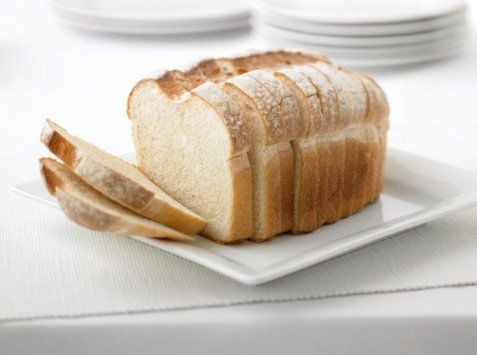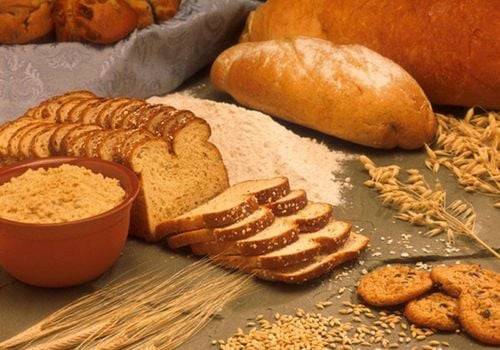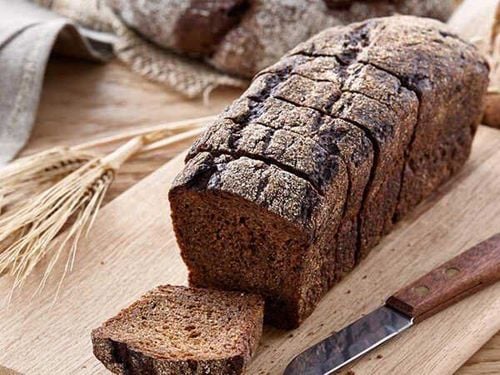This is an automatically translated article.
White bread has become a familiar food for many people. But recently with the appearance of black bread, people have many opinions about the difference between black bread and white bread. The article will provide more information about these two types of bread.1. How to judge the difference between white and black bread
Almost all breads are made the same way, except that the ingredients in the bread include gluten and grains. Breads are all produced using the yeast in the dough from wheat or rye grains. The manufacturing process of flour converts the simple sugars present in the flour. The powder rises as the alcohol and carbon dioxide are released. When the flour is baked, the yeast dies and tiny pockets of carbon dioxide are left behind, giving the bread its incredible texture.
2. Nutritional difference of white bread and black bread
The bran in wheat flour provides quite rich nutritional components including: magnesium, manganese, vitamins B and E, iron, zinc, potassium and phosphorus. Furthermore, bread also contains fiber and phytonutrients commonly known as plant lignans. These phytonutrients are known to protect against heart disease and breast cancer. Many people assume that the calories in white bread and black bread are the same.
The flour of white bread is said to be rich in minerals and vitamins. The Food and Drug Administration (FDA) also requires supplementation of folate, thiamin, iron and niacin lost during bread making to avoid nutritional deficiencies.
White bread: In 100 grams of white bread contains about 304 calories. In addition, white bread provides powdered sugar, fat, and protein. Bread also provides a rich source of thiamin (vitamin B1) and folate (vitamin M). The composition of white bread also contains more sodium (sodium) and a higher glycemic index than black bread.
Black bread : In 100g of black bread contains about 284 calories. However, the fiber content in rye bread is four times higher than in white bread. Black bread is also rich in B vitamins. The glycemic index (glycemic index of foods) is lower than white bread.

Hàm lượng chất xơ trong bánh mì đen cao hơn gấp 4 lần bánh mì trắng
3. Appearance of white bread and black bread
Both black bread and white bread are made with flour. The composition of a grain of wheat flour consists of 3 parts: the bran part, the germ part and the endosperm part. The large center of the protein and starchy flour grain is the endosperm. During germination, this central region germinates. Wheat flour is also rich in minerals, vitamins and oils. The composition of bran is rich in fiber and a number of nutrients. The bran also covers both the germ and the endosperm.
In white bread, the flour is more refined than in whole wheat bread. When processing, leave only the white, starchy endosperm and remove the germy bran layer of the wheat grain. The germ and bran are left in whole wheat flour, which is why it has more fiber and nutrients than white flour.
3. Advantages and disadvantages of white bread and black bread
3.1. Cost and Accessibility
White bread is more economical than black bread, although it has steps in the refining process. White bread is ubiquitous and mass-produced.

Bánh mì trắng dễ tìm mua hơn
3.2. Predictability
Bread uniformity is guaranteed in the case of white bread. It also has a bland taste, yet it is the perfect and vital ingredient for making sandwiches.
Most people feel that rye bread tastes better whether sprouted, fermented or bacterially fermented. This is due to the addition of germ and bran.
3.3. Structure
Black bread has a more varied texture while white bread has a chewy texture. Preferences are completely subjective.
4. Frequently asked questions about black bread and white bread
4.1. Is rye bread healthier than white bread?
Black bread is better than white bread. This is because rye bread has many nutritional advantages. Black bread is rich in fiber, and this fiber is removed from white bread during mechanical refining. Fiber controls blood sugar levels, normalizes bowel movements, and also helps lower cholesterol. Black bread may also help reduce high blood pressure, digestive disorders, stroke risk, and obesity. The germ and bran of rye bread are rich in minerals and vitamins.
White bread often has multivitamins that the body cannot fully absorb. Furthermore, white bread may have preservatives and added sugar. Black bread is healthier than white bread because it has fiber in it.
4. 2. Black bread or white bread has an effective weight loss effect
People eat white or rye bread to lose weight because they think they have the same nutritional value. White bread is more processed than whole grain bread. Due to this processing, the germ and bran are removed in white bread, leaving only the starchy, white endosperm left. Thus making white bread low in nutrients. Furthermore, white bread also has added sugar and high-fructose corn syrup. Excessive consumption will cause weight problems and also lead to other degenerative diseases like cardiovascular problems and diabetes.
On the other hand, whole wheat flour contains more nutrients because the germ and bran are intact. So, if you are looking to lose weight, you can choose to eat rye bread to promote weight loss.
4.3. Black bread or white bread has the effect of building muscle of the body
For a muscle building diet, the right bread should be a good source of carbohydrates and nutrients. White bread has less protein than black bread, and protein is important for muscle growth. Black bread is also high in complex carbs, which are also an important macronutrient for bodybuilders. So brown bread is great for body building
If you are a regular bread eater, then you should consider switching to unrefined whole wheat. To ensure that you are getting a minimum of additives and maximum nutrition, you can look for a product with a lesser amount of ingredients.
5. Some notes when using bread
Bread is often seen as a food that does not provide enough nutrients for the body. Therefore, you should use bread in a reasonable way to ensure that you can add other nutrient-rich foods.
Moreover, people with diabetes should not add bread to their daily diet, especially white bread.
Black and white breads are all made with barley, wheat, and rye, so bread has the ability to produce natural mucus in the body. So when you eat these types of bread, you may face the risk of nose problems, mucus congestion.
Bread has a high starch content in its nutritional composition. Therefore, if you eat bread regularly, it may be a risk factor for weight gain. For example, you can use about four slices of bread, which will provide 140 mg of calcium to help keep your bones strong and will not make you gain weight.
Please dial HOTLINE for more information or register for an appointment HERE. Download MyVinmec app to make appointments faster and to manage your bookings easily.
Reference source: parenting.firstcry.com













